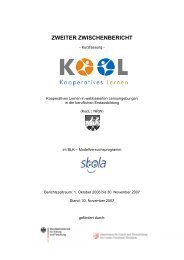ERSTER ZWISCHENBERICHT - e-Learning-Portal
ERSTER ZWISCHENBERICHT - e-Learning-Portal
ERSTER ZWISCHENBERICHT - e-Learning-Portal
Sie wollen auch ein ePaper? Erhöhen Sie die Reichweite Ihrer Titel.
YUMPU macht aus Druck-PDFs automatisch weboptimierte ePaper, die Google liebt.
Transcript of the film on glass history – part 1:<br />
It’s not difficult to establish the impact of clocks on industrialization. The role of glass is more mysterious.<br />
“Glass has an extraordinary combination of properties. It’s almost completely inert, so you can use it stoked up, it’s<br />
very transparent, if you make it properly, so you can see what you’ve got inside. And it’s malleable, you can turn it<br />
into a very large number of different shapes. And because of its effects on light, you can use it to set light on things,<br />
magnify them, bring them closer or further away, correct optical defects. And it’s impossible to imagine, for example,<br />
modern sciences without glass, without telescopes and microscopes, without thermometers and barometers. It’s<br />
impossible to imagine a huge range of industries, especially chemical technologies without glass. Now, that’s almost<br />
a magical combination of properties. And to think about how the modern world’s produced, and how we get there, I<br />
think it’s very important to look at who was able to make glass and why.”<br />
Glass making was an ancient craft, known to the Phoenicians, Egyptians, and the Romans. By the 15 th century, the<br />
best glassmakers came from Venice. Alan Macfarlane went to the island of Murano, where some of the finest<br />
craftsmen developed their skills.<br />
“The Italians, as we all know, make wonderful wine, and unlike hot drinks, this can be served up in glass. So they<br />
began to realize that if you made this crystalline, clear, reflecting medium you would get the goal of Athens: of<br />
beauty to the eye and beauty to the stomach, and so they began to make more and more beautiful wineglasses. And<br />
of course this affected the technology which got better and better.”<br />
Secrets of their craft became so valuable that they were not allowed to leave the island of Murano for fear of<br />
industrial espionage. Glassmaking became an important medieval industry across Europe. Just as the mechanical<br />
clock revolutionized the perception of time, so the use of glass changed the European understanding of space.<br />
“Most of the glass in the West is used not for vessels most of the time. It’s true, isn’t it?”<br />
“No, it’s true for Southern Europe, which is a warm area, where they drink wine, it’s for vessels.”<br />
”It’s windows in the North.”<br />
“That’s right”<br />
“There it is for beauty, for protection against the weather, for the glorification of god.”<br />
But gradually, as glassmaking techniques improved, the demand for glass increased. The manufacturing of crown<br />
glass for windows became widespread. Tony Cummings, who has been making crown glass for twenty years,<br />
showed Alan Macfarlane the skills involved. The trick is to create a flat sheet from a large sphere of molten glass. As<br />
Tony spins the glass, centrifugal forces flatten the hollow sphere into a disk. Today these are sometimes used in pubs<br />
and tea-shops but originally the centre was thrown away and the glass was cut into window panes.<br />
Monasteries and churches were the among the first medieval institutions to use glass for windows. Soon they began<br />
to be installed in houses, and other buildings too. The increasing use of glass and clocks created a more orderly and<br />
controlled world. It was clearly seen in many homes with their enormous windows. Glass not only let in more light<br />
but made every mote of dust visible. With large windows, there were no dark corners to hide traces of dirt. The<br />
windows created a new hygienic environment, it began with the glass pane itself, the desire to have clean windows.<br />
Eventually, cleaning became an important ritual in everyday life, to be extended to the scar in the floor and polishing<br />
the textiles. So indirectly, glass wiped away disease.<br />
It also obviously extended the working day, the workmen, they could work into the evening with glass windows. So it<br />
alters perception, it alters comfort, it alters working hours, it alters religion, every part of human life. But not in<br />
China, not in Japan, not in India, not in Islam, not in South America, not in Australia, not in South Africa. Just in this<br />
wet, cold, and miserable part of North West Europe the great window revolution occurs.<br />
The West became flooded with glass. And this changed all sorts of things. It changed the idea of space, time and<br />
person, the individual. But there was one change that was particularly important. That was that with glass you can<br />
make scientific instruments, you can draw it out in all sorts of shapes, so that you can make containers, you can<br />
make thermometers, and barometers, and telescopes, and microscopes, and so that made it possible to establish the<br />
fundamental laws of chemistry and physics. And without these laws you could not have had a steam engine.<br />
Seite 130






